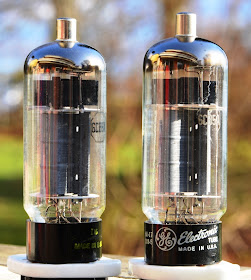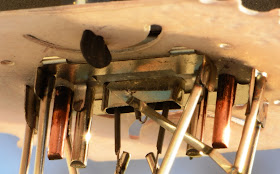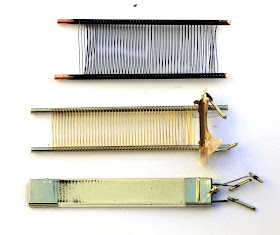The 6CB5A was already covered in the very first Tube of the Month post of my blog. It still is my favorite choice of indirectly heated output tubes. I saw some increasing interest in this tube during the recent months and I just finished a new amplifier which uses this tube. So I thought it deserves another covrage as tube of the month.
The technical aspects of the tube have already been covered in the post in 2011, so they won't be repeated here. Instead I'd like to show more photos of various 6CB5A tubes and also it's construction details.
Here a small selection of 6CB5A tube boxes from various brands:
The tube was made in various variations. Even tubes from the same manufacturer can differ in construction. Some have cooling fins for the screen grid, some don't. Some have the getter applied at the top and others somewhere at the side. The plates can have various shapes.
This is the most common version I have seen from RCA:
A quite different one, also from RCA:
While the first one has the getter at the side, the second one has it in the top. But a more significant difference are the cooling fins attached to the support rods of the screen grid in the second tube, while the first one does not have this additional cooling. The plate structures also differ quite significantly.
The 6CB5A is a good example of cross branding. The second RCA from above actually looks remarkably close to a General Electric version:
The internal construction of these tubes is almost identical. Only the size of the cooling fins is a bit different:
Could be they sold tubes to each other or sourced the same parts from a common supplier.
The Tung-Sol on the left in the picture below has the exact same internal construction as the GE:
Only the base of the Tung-Sol is much wider. The next photo shows a Raytheon compared to the same GE:
These two are absolutely identical, also the size and shape of the cooling fins is the same.
The next photo shows a different 6CB5A variant from General Electric next to a Sylvania which looks extremely similar:
These have a single cooling fin attached to the screen grid support rods:
Yet another variant, Raytheon branded:
This one has the cooling fins in peculiar shapes:
Next a 6CB5A from DuMont:
Although DuMont did not have it's own tube manufacturing but sourced form other companies, I have not seen a 6CB5A from other brands with the same construction as this.
So the 6CB5A is a great example for the cross branding during the tube era. It seems that even the big manufacturers occasionally sold tubes to each other and just slapped their brand names on.
The earlier variant of the tube, the 6CB5 without the A-suffix, was made in a beautiful ST shape:
Besides the different shape it also had a wider base. 6CB5 and 6CB5A are pin compatible, but if the socket is mounted below the chassis, the hole above the socket needs to be much wider for the ST shape. Some of the 6CB5A versions with straight sided glass also have this wider base, like the Tung-Sol shown above. The next photo shows the bases in comparison:
The 6CB5 plate voltage rating is a bit lower. Apparently the 6CB5 was only made over a relatively short time. While the 6CB5A is commonly available, the 6CB5 is quite difficult to find.
Now after we saw different variants of the tube, let's take one apart to check out the internal construction. We will use this RCA tube:
First we remove the top cap (plate connection) :
Then the glass has to come off:
Now we have a better view at the internals. The top end, showing the mica disc which aligns all the electrodes and supports them inside the glass:
A close up showing the heater inside the cathode:
The bottom mica and all the connections between electrodes and base:
A close up from the other side:
Next the top mica gets removed so that the plate can slide off:
Now we see the beam forming plate and the grid around the cathode. But wait a minute, we see one grid only? It is supposed to have two grids between cathode and beam forming plate, the control grid and screen grid. Let's have a closer look:
Now we see both grids. The screen grid wires are wo well aligned to the control grid, that they are difficult to see. The top mica was already removed so the alignment is a bit skewed, because the support at the upper end is gone. That's why both grids become visible in that photo. A close up:
This photo also nicely shows the cathode coating. A quite rough surface!
Let's have a look from the top:
A close up:
The grid wire seems to be gold plated for reduction of grid emission and the screen grid is coated probably for better heat dissipation. Let's pry the beam forming plate away to get a better view:
Zooming in:
Now the spray coating on the screen grid is nicely visible. The alignment of the grids got destroyed by removing the beam forming plate.
Grids and cathode separated:
Another photo of the beautiful control grid:
The control grid with a scale to give an impression of the dimensions:
Since the tube has a low amplification factor, no tiny distances are needed. The grids are a bit less than a millimeter apart. But the precise alignment of the two grids is spectacular.
Let's have a look at the cathode and heater which is now removed from it:
The black stains got onto the cathode when I removed the grids.
A close up of the cathode surface:
And a close up of the heater, which has a rather thick insulation:
As mentioned above, this is still my favorite indirectly heated output tube. Several amps with this tube have already been shown on my blog. The owner of the first 6CB5A amp I built is still happily using it every day. The 6CB5A seems to be very robust as I have not seen any problems with it so far.
I just finished another single ended amp with a triode connected 6CB5A:
This is a quite elaborate implementation of my 6CB5A concept. The driver tube is the 6N7. Interstage transformer is the Tango NC20F, output transformer is Tango FC30-3.5S. The power supply is external in it's own chassis. Here a photo of amp and power supply together:
The amp during construction: Some heater and signal wiring done:
The inside of the finished amp:
And the inside of the power supply:
And finally some shots of a 6CB5A in operation:
The glowing heater from the top:
The bottom side:
I hope you enjoyed this first Tube of the Month article of 2013! Stay tuned for many more posts about interesting vaccum tubes!
Best regards
Thomas
















































Hi Thomas,
ReplyDeletefirst I like to wish you a happy new year! Hope you started well and had some nice time. I really enjoy to read your articles so keep on going!
I also noticed the differences in shapes and internal structures, since I already have a couple of 6CB5A from several brands. I am really excited about their sound and I can't wait anymore to finish my amp and listen to the first song ;-)!
What's the secret about the additional choke in the pictured amp!? Did you add another filter for the driver tube?
Thanks and best regards,
Niko
Hi Niko,
ReplyDeleteyes, in this amp the driver staes have their own LC decoupling filters.
Thomas
Hi Thomas, a nice and interesting work you did with that tube!
ReplyDeleteBut did you try PSE configuration? If not, do you see any problem doing it? Thanks Pierre
Hi Pierre,
DeleteI never tried PSE with the 6CB5A, I see no reason why it would not be feasible. tubes need to be carefully matched though since variation is quite high between them. I always match with a curve tracer
Thomas